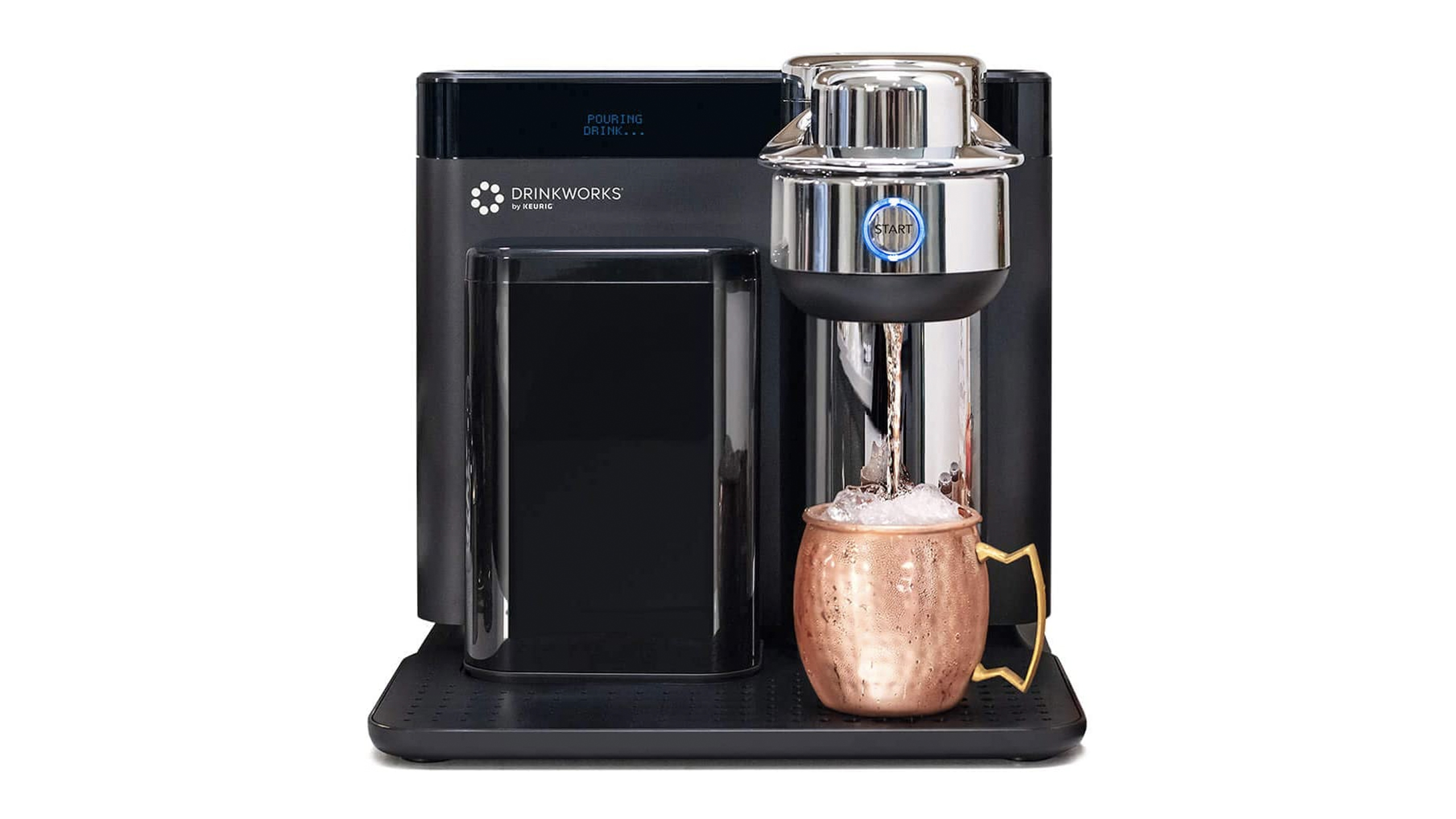I’ve always wanted a flying car like the ones in The Jetsons. But despite 80 years of flubbed attempts, and an awful lot of ink spilled over at Popular Science, I still don’t have one in my driveway—and it’s not even close.
But I do have a robot in my kitchen that makes cocktails. So that’s cool, right?
The folks at Bartesian sent me this thing. It’s big, it takes up more room than the coffeemaker, but it holds four large glass tanks of liquor: whiskey, tequila, vodka and an interchangeable slot for rum or gin. You fill those up with your favorite spirits, which is a nice nod to customization, and there is a built-in water reservoir that’s used for dilution.
The heart of the system are the Keurig-like “pods.” They contain the juices and bitters and such that turn whiskey and water into an Old-Fashioned, or vodka into a Cosmopolitan, and so on. You lift the front lid of the Bartesian, in a definitely Keurig-like fashion, put in the drink pod and push down the lid.

Just put a glass filled with ice under the spout and select the strength of the drink you want. The machine reads a code on the pod to see what it’s making, there’s a light whirring sound and in less than 30 seconds your cocktail is ready.
The biggest surprise for me: It doesn’t stink! We’ve been using the contraption for several weeks and even had some friends over—at a social distance—and we all pretty much agreed with my friend Sam’s judgment: “That it’s shockingly good!” We were honestly surprised at the quality of every one of the admittedly simple cocktails we made, including an Old-Fashioned, a Whiskey Sour, a Cosmopolitan, a Margarita and a Sex on the Beach.
Keurig does make its own cocktail robot, called Drinkworks. It’s more flexible, and the cocktails can be chilled, pumped with CO2 to a light fizz, or even warmed if required. It’s more compact, but the trade-off is that Keurig picks the booze. Their pods come pre-filled with “Caribbean rum” and “Blended whiskey” and “Gin.” You buy the pods where you buy liquor.
It’s fun, it’s easy, it’s quick. So, what’s not to like?
Let me ask you a different question. Do you remember the first time you had a really good cocktail?
I do.
Back in the early ’80s, I was tending bar during grad school. I poured a lot of draft beer and I made a lot of Whiskey Sours. Any kind of sour, really; I also regularly made them with apricot “brandy” and rum, and one guy got Kahlúa Sours, which looked like used motor oil.
Sours were easy, I mean, E-Z. Grab a shaker glass and dump in a three-count of booze, a barspoon of superfine sugar, two glugs of Daily’s Sweet & Sour Mix (“A little sweet, a little sour”) and fill it with ice. Cap it, shake it and strain it into a chilled Nick & Nora glass. Finish the drink with a bright red and syrupy sweet cherry.
I thought that was a Whiskey Sour and I thought they tasted like crap. I’d rather have an honest 7&7.
Then around 1983, I went to a real cocktail bar for the first time. The bartenders wore white jackets and tuxedo shirts with black bow ties. They worked with a huge selection of bottles behind a gorgeous wooden bar and they muddled, stirred and shook. But the thing that caught my eye was a tall mechanical tool bolted to the bar.
It was an old-school juice press. Someone ordered a Whiskey Sour, and the bartender sliced a lemon, put one half into the machine, rotated the handle and slickly pressed every drop of fresh juice into the shaker. He added the whiskey, sugar and ice, then shook it hard and strained it into a freshly polished glass. It looked so good, I had to have one.
It was a revelation. With the fresh lemon juice slamming against the whiskey’s sweetness (and the sugar dialing down the acidic bite just enough), it was a drink that made my mouth jump, and brought that tingling tightness back at the joints of my jaw.
Sour mix is better now than it was, even though it’s not fresh lemon juice. Yet, it’s still used in thousands of bars; even Fee Brothers, famous for its pioneering line of artisanal bitters, sells four different kinds of sour mix.
It’s no real mystery. We use sour mix for the same reason we buy hard seltzer instead of splashing vodka in a glass of LaCroix. It’s easy. Easier than having lemons on hand, easier than squeezing them and easier than cleaning all that up afterwards.
It’s convenience. I wind up cooking dinner most days for my family because my schedule is pretty flexible, but I still need time. So I freely use shortcuts: minced jarred garlic, pre-ground spices and spice mixes, and even frozen chopped onion. I still use whole cloves of garlic. I still slice fresh onions, scallions and shallots. I often grind pepper (and buy peppercorns with an eye to freshness), but not when I’m short on time.
It’s still cooking, though, not reheating. The cans of soup and baked beans on the shelf are for when I’m absolutely out of time, and just need some quick nutrition to keep going. I’m not buying bags full of frozen dinners, cans of Spaghettios, or even boxes of cookies (my daughter loves baking cookies).
I remember when we did eat from cans, and my mom made “spaghetti sauce” with spice packets and canned tomato sauce, and baking was something you did for the holidays. Our refrigerator and pantry were full of canned meals, just-add-water mixes and frozen Sara Lee pies. My parents were decent cooks, but there was almost a feel that “homemade” was inferior and out dated, and certainly not special.
Are we dancing on that line again? When we can get a cocktail robot, when we can buy pre-made pouches of tikka vegetables at Trader Joe’s and when you find pre-cooked bacon in the supermarket, I have to wonder if things have come around again. Maybe it’s just at a higher level, more like climbing a round of a spiral. There are so many more shortcut options now, and they’re truly better options than we had before.
Take the cocktail robots. Compare them to the “instant cocktails” from the 1960s, like The Pussycat, a packet of powder you added to Early Times Whiskey and water, and stirred. The robots take up more room, but the ingredients aren’t dehydrated, the portions are measured and mixed with precision. It makes a better drink.
Instead of cans of Chef Boyardee Raviolis, we have pre-made sauce from New York restaurant Rao’s. We can get a home delivery service like Blue Apron, that sends you pre-cut meal ingredients and is so popular that it has spawned numerous imitators. We have cocktail robots.
Are those bad things? No. That’s ridiculously judgmental. I once had someone shame me when they spotted a disposable shaker of pepper on my table in a Facebook post. Get serious. If you can bake all your own bread, grind all your spices (and coffee) on demand, grow all your vegetables and herbs in a garden, and cook every meal from scratch (take-out is cheating), and still work a full-time job, God bless.
But to be able to do those things when you can is a true blessing. I shop for ingredients, I cook and I enjoy it. I have a full spice selection, way too many salts, sauces, and mustards, and I use them all, regularly. I’m happy that they’re available.
And I haven’t stopped making cocktails. A friend came over a few nights ago for dinner and brought a bottle of contraband Cuban rum, simple syrup and a sack of limes. We pressed limes (yeah, I finally bought a juice press last year, had to have one), smacked fresh mint between our palms and shook the hell out of some Old Cubans. It was great fun and they were delicious.
The cocktail robot sat there on the shelf, quiet, dark, unneeded. If I’d bought the machine (it lists for $350) and the pods, instead of being given it all by the company to test out, I’d probably would have felt like we should be getting our money’s worth out of it. But the Bartesian has no idea how to make an Old Cuban. It has no way to create a Champagne float and certainly no hands to smack mint leaves.
As so many cautionary tales about robots have told us, you still need a human for that.










